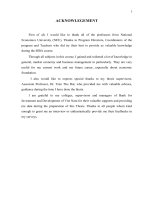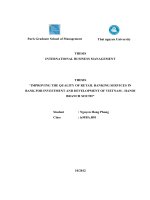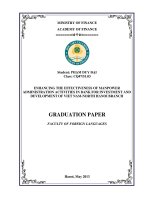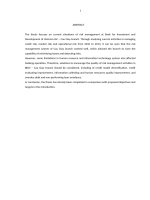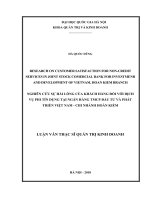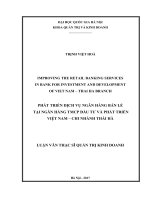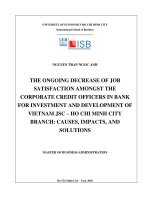Improving the retail banking services in bank for investment and development of viet nam – thai ha branch
Bạn đang xem bản rút gọn của tài liệu. Xem và tải ngay bản đầy đủ của tài liệu tại đây (1.59 MB, 100 trang )
ĐẠI HỌC QUỐC GIA HÀ NỘI
KHOA QUẢN TRỊ VÀ KINH DOANH
---------------------
TRỊNH VIỆT HOÀ
IMPROVING THE RETAIL BANKING SERVICES
IN BANK FOR INVESTMENT AND DEVELOPMENT
OF VIET NAM – THAI HA BRANCH
PHÁT TRIỂN DỊCH VỤ NGÂN HÀNG BÁN LẺ
TẠI NGÂN HÀNG TMCP ĐẦU TƯ VÀ PHÁT TRIỂN
VIỆT NAM – CHI NHÁNH THÁI HÀ
LUẬN VĂN THẠC SĨ QUẢN TRỊ KINH DOANH
Hà Nội - 2017
ĐẠI HỌC QUỐC GIA HÀ NỘI
KHOA QUẢN TRỊ VÀ KINH DOANH
---------------------
TRỊNH VIỆT HOÀ
IMPROVING THE RETAIL BANKING SERVICES
IN BANK FOR INVESTMENT AND DEVELOPMENT
OF VIET NAM – THAI HA BRANCH
PHÁT TRIỂN DỊCH VỤ NGÂN HÀNG BÁN LẺ
TẠI NGÂN HÀNG TMCP ĐẦU TƯ VÀ PHÁT TRIỂN
VIỆT NAM – CHI NHÁNH THÁI HÀ
Chuyên ngành: Quản trị kinh doanh
Mã số: 60 34 01 02
LUẬN VĂN THẠC SĨ QUẢN TRỊ KINH DOANH
NGƯỜI HƯỚNG DẪN KHOA HỌC: TS. NGUYỄN THỊ KIM OANH
Hà Nội - 2017
DECLARATION ON HONOUR
I confirm that I have written the present thesis independently and without
making use of any sources or references other than those explicitly stated in th e
bibliography.
Passages extracted literally or as regards content from the sources and
references listed in the bibliography are identified in the thesis as a citation or a
paraphrase.
This master thesis has not been previously published and has thus neither
been made accessible to other interested parties nor submitted to another
examination authority
Date…………………………..
Author
Trinh Viet Hoa
i
ACKNOWLEDGMENT
To finish the dissertation "Improving the retail banking services in Bank for
Investment and Development of Vietnam - Thai Ha Branch ", I would like to thank
all the teachers for teaching and helping. I studied in Viet Nam National University,
Ha Noi School of Business and Management.
I would like to express my sincere thanks to the dedicated help of instructor
Dr. Nguyen Thi Kim Oanh, Board of Directors of Deposit Insurance Viet nam – Ha
noi Branch.
I would like to thank my friends, colleagues, relatives and family who have
always been with me, encouraged and helped me during my study and research.
Although we have tried our best to study the topic, due to limited time,
knowledge and practical experience is still limited, so I can not avoid the lack of
research, I hope to receive the comments of teachers, friends, colleagues to
complete the thesis.
I sincerely thank!
ii
TABLE OF CONTENT
DECLARATION ON HONOUR ................................................................................i
ACKNOWLEDGMENT ............................................................................................ ii
OVERVIEW ..............................................................................................................ix
TABLE OF CONTENT ............................................................................................ iii
ABBREVIATIONS....................................................................................................vi
LIST OF FIGURES.................................................................................................. vii
LIST OF TABLES .................................................................................................. viii
CHAPTER 1: INTRODUCTION TO THESIS ..........................................................1
1.1. The urgency of the thesis .................................................................................1
1.2 Purpose of thesis ...............................................................................................2
1.3 Subjects and scopes of study ............................................................................2
1.4 New contributions of the thesis .......................................................................3
1.5 Structure of the thesis .......................................................................................4
CHAPTER 2: BASIC ISSUES ON IMPROVING RETAIL BANKING SERVICES
AT COMMERCIAL BANK .......................................................................................5
2.1 Literature review ...............................................................................................5
2.2 Retail banking activities of commercial banks .................................................7
2.2.1. The over view of Commercial Bank ........................................................7
2.2.2. The Concept of Retail Banking Services .................................................8
2.2.3. Characteristics of retail banking ...............................................................9
2.2.4 Retail banking products ...........................................................................11
2.3. Improve retail banking ...................................................................................16
2.3.1 Theory of improvement of retail banking ...............................................16
2.3.2 The role of retail banking service improvement .....................................17
2.3.3 Criteria for assessing retail banking improvement ..................................19
2.3.4 Factors affecting the improvement of retail banking ..............................23
iii
2.4 Experience in retail banking improvement in some banks around the world
and experience in Vietnam ...................................................................................30
2.4.1 Experience improving retail banking in some banks around the world ..30
2.4.2 Lessons learned for Vietnamese commercial banks ................................32
Conclusion Chapter 2 ................................................................................................33
CHAPTER 3. RESEARCH METHODOLOGY AND IMPROVEMENT OF
SURVEY INSTRUMENT ........................................................................................34
3.1 Research methodology....................................................................................34
3.1.1 Type of research and data analysis methodology ....................................34
3.1.2. Research data ..........................................................................................35
3.1.3. Sampling and data collection..................................................................36
3.1.4. Research models .....................................................................................37
3.2. Develop questionnaire ...................................................................................38
CHAPTER 4. SITUATION OF IMPROVING RETAIL BANKING SERVICE IN
BIDV – THAI HA BRANCH ...................................................................................40
4.1. Overview of business activities of BIDV Thai Ha branch ...........................41
4.1.1. The process of formation and development ...........................................41
4.1.2. Organizational model .............................................................................41
4.1.3 Evaluating results of business activities of BIDV, Thai Ha branch ........42
4.2. The status of retail banking services of BIDV - Thai Ha Branch..................45
4.2.1 The status of retail banking services and retail banking services turnover
at BIDV Thai Ha branch...................................................................................46
4.2.2 Current price / charge situation in capital mobilization, lending and retail
services .............................................................................................................58
4.2.3. Current status of facilities and equipment for RETAIL BANKING
activities ............................................................................................................59
4.2.4. Current status of human resources for RETAIL BANKING activities .60
4.2.5 The current state of information technology infrastructure for retail banking61
4.3 Achievements and limitations of retail banking service of BIDV – Thai Ha
branch ....................................................................................................................63
iv
4.3.1 Achievements ..........................................................................................63
4.3.2 Limitations ...............................................................................................64
4.4. Reason ............................................................................................................66
4.4.1. Subjective reasons ..................................................................................66
4.4.2. Objective reasons....................................................................................69
Conclusion Chapter 4 ................................................................................................71
CHAPTER 5: SOLUTIONS TO IMPROVE RETAIL BANKING SERVICES IN
BANK FOR INVESTMENT AND DEVELOPMENT OF VIETNAM, THAI HA
BRANCH ..................................................................................................................72
5.1 Trends in improving retail banking services in Vietnam ...............................72
5.2. Orientation of retail banking improvement at BIDV, Thai Ha branch to 2020 ....73
5.2.1. General direction ....................................................................................73
5.2.2. Orientation of improving retail banking .................................................74
5.3. Solutions to retail banking improvement at BIDV, Thai Ha Branch ............74
5.3.1. Solutions group on retail banking services packages .............................74
5.3.2 Group of personnel solutions...................................................................75
5.3.3 Technology Solutions Group ...................................................................76
5.3.4 Customer service solutions ......................................................................77
5.4. Requests .........................................................................................................78
5.4.1. Recommend to Vietnam Development Commercial Joint Stock Bank .78
5.4.2. Recommendations to the State Bank and other ministries .....................81
CONCLUSIONS .......................................................................................................83
BIBLIOGRAPHY .....................................................................................................84
APPENDIX ...............................................................................................................86
v
ABBREVIATIONS
BIDV
Bank for Investment and Development of Vietnam - Thai Ha Branch
CAR
Capital Adequacy Ratio
IT
Information Technology
IFRS
International Financial Reporting Standards
VAMC
Vietnamese Asset Management Company
VAS
Vietnamese Accounting Standards
WTO
World Trade Organization
vi
LIST OF FIGURES
Figure 3.1. The quantitative research process (Author, 2017) ..................................35
Figure 3.2. Research framework ...............................................................................37
Figure 4.1. Organization structure framework of BIDV – Thai Ha branch ..............42
Figure 4.2. Service package of BIDV Thai Ha .........................................................46
Figure 4.3. BIDV's capital mobilization situation, Thai Ha branch from 2015 to 2016 .....47
Figure 4.4. Situation of BIDV's term deposit mobilization, Thai Ha branch from
2015 to 2016 ..............................................................................................................48
Figure 4.5. Credit structure .......................................................................................49
Figure 4.6. Implementation Status Of Retail Outstanding Loan over the times .......49
Figure 4.7. Outstanding loans of BIDV – Thai Ha Branch compared to the whole
system ........................................................................................................................50
Figure 4.8. The structure of incomes from operations (not including business
operation expenses) ...................................................................................................52
Figure 4.9. Income and expenditure structure of BIDV – Thai Ha Branch compared
to BIDV system .........................................................................................................53
Figure 4.10. Foreign Exchange Profits of BIDV, Thai Ha Branch ...........................54
Figure 4.11. Price of BIDV- Thai Ha branch in comparison to other competitors...58
Figure 4.12. Status of facilities and equipment for retailing bank ............................60
Figure 4.13. Infrastructure of equipment supplying services ...................................61
vii
LIST OF TABLES
Table 4.1. Financial Report of BIDV - Thai Ha Branch ...........................................43
Table 4.2. Descriptive Statistics ................................................................................45
Table 4.3. Retail sales of BIDV Thai Ha increased over the years. .........................50
Table 4.4. Net income from card services, POS .......................................................54
Table 4.5. Some results on international credit card products ..................................56
Table 4.6. Result of BSMS service of BIDV Thai Ha branch ..................................57
Table 4.7. Results of BIDV's domestic payment service fee, Thai Ha branch from
2015 to 2016 ..............................................................................................................58
viii
OVERVIEW
Studying the challenges facing Vietnam's banking and finance industry, experts
have concluded that one of the two challenges facing the banking industry is the fierce
competition in service quality. In addition, in the development strategy of Vietnamese
banks in the coming years, the diversification of products and services and the
improvement of quality of products and services is a vital issue, in parallel with the
provision of credit to the economy. The Bank will survive and develop sustainably.
Vietnam Commercial Joint Stock Bank for Investment and Development
(BIDV) is a commercial bank established in 1957 in the form of a state commercial
bank, and since April 2016 BIDV officially became a joint stock commercial bank.
The state holds 95% of the shares with a dense network and a large market. In fact,
from its inception to 2000, BIDV has been mainly serving capital construction
projects and projects in the economy, but from 2000-2016, BIDV entered the
integration period, in parallel with the credit growth. BIDV has also actively shifted
its customer structure to reduce the proportion of outstanding loans and develop
credit service products. However, BIDV is too focused on developing credit and
investment, while investment in modern banking products and services accounts for
a modest share.
BIDV, Thai Ha branch was established in May 2015 with the traditional
activities of credit, capital mobilization and services. In the business strategy of the
past 3 years, BIDV's goal is to become a leading bank providing banking products
and services in Vietnam. and will constantly improve the quality of products,
develop banking services. Based on the above reasons, the authors selected the
topic: "Improving the Retail banking services in Bank for Investment and
Development of Viet Nam - Thai Ha Branch" to increase income from banking
services and enhancing competitiveness and reducing risks for Thai Ha Branch and
contributing positively to the joint venture business as well as contributing to the
state budget and creating jobs for local laborers.
ix
CHAPTER 1: INTRODUCTION TO THESIS
1.1. The urgency of the thesis
Along with the socio-economic development, the activities of commercial
banks are increasingly developed and reached certain achievements in many aspects
such as technology modernization, supplying of new products and services, risk
managements, customer-oriented restructuring... Accordingly, retail activities
account for a large proportion in commercial banks and bring about many benefits.
On the socio-economic perspective, retail activity contributes to improving people's
living standards, reducing social costs, and improving civilization in payment.
Considering the financial and management aspects of banks, retail operations
reduce risks, creating stable sources of income for banks. This is a fast-growing
trend of commercial banks in the world in recent years.
In Vietnam, under the pressure of: competition from other credit and noncredit institutions, foreign banks, increasing in understanding and demand of the
bank, and the development of information technological advances and retail
activities of commercial banks in recent years have made remarkable progress;
however, there are many shortcomings such as: lack of synchronism in the
development of retail banking activities. Service products are traditional, poor in
category, utility is not high. Service quality is low. The level of technology
application in service development is limited. Distribution channels are not
diversified and ineffective. Marketing sales are passive due to lack of full
customers’ information system. There is no set of indicators to assess retail
performance as well as effective risk management. The effectiveness of retail
banking on the social and economic aspects is quite modest.
Meanwhile, with the potential market of nearly 100 million people, foreign
banks, non-banks, non-banks, and non-financial institutions are acting aggressively
to gain market share in this field. The Bank for Investment and Development of
Vietnam (BIDV) have the same vision. In recent years, in addition to providing
traditional products to corporate clients, the Bank for Investment and Development
1
of Vietnam There are strong directions in the development path that retail banking
products are considered as a long-term business strategy and conditions for
sustainable development in their operations.
However, the development of retail banking products at BIDV has not changed
dramatically; the retail banking products and services have not yet reached the
customers, and the retail market share is not high in business activities. Together
with the trend of BIDV, Thai Ha branch - new branch in BIDV system, with the
former branch of Mekong Delta Bank House (MHB Ha Tay) was merged into
BIDV in May 2015 Government policy.
Since its founding, Thai Ha has focused on retail development. However,
new retail banking activities are still inadequate. Therefore, the improvement of
synchronous and creative solutions to develop the retail banking products at the
branch will contribute to fulfilling BIDV's goal.
Based on the above reasons, with the desire to find out solutions in a
consistent, effective and practical way to develop retail activities of BIDV - Thai Ha
Branch, I chose the problem: Retail banking at the Bank for Investment and
Development of Vietnam - Thai Ha Branch as the thesis topic.
1.2 Purpose of thesis
Studying and researching the basic theoretical issues of development of retail
banking activities of Vietnamese commercial banks.
Reflects and assesses the development of retail banking activities of BIDV
Thai Ha branch including analyzes the shortcomings, constraints and causes
affecting the development of retail banking activities of the branch.
Suggest some solutions to help BIDV Thai Ha branch in particular and
commercial banks in general to promote banking services at BIDV Thai Ha branch
to bring efficiency to the branch, reduce risks, contribute enhancing competitiveness
and sustainable development.
1.3 Subjects and scopes of study
Subjects of study: Improving retail banking activities of BIDV Thai Ha
branch.
2
Research scope:
-
The improvement of retail banking services at BIDV Thai Ha branch in 2015, 2016;
-
Direction and solutions to improve services of BIDV Thai Ha branch to 2020.
1.4 New contributions of the thesis
Theoretically, the thesis has made a systematic approach and explanation to
further clarify the basics of retail banking activities of commercial banks with an
independent role for sustainable development of banking activities and commercial
banks retailing.
In terms of practical research: Based on the analysis of BIDV's retail
operation in Thai Ha in recent years, the thesis has identified certain achievements,
shortcomings and constraints. In retail banking activities, this is the field of activity
that foreign banks, non-NH financial institutions are particularly interested in
exploiting in the US market. Therefore, in order to win the fierce competition, the
general banks in Vietnam and BIDV Thai Ha branch in particular must inevitably
focus on the development of retail banking activities.
About practical application: The thesis analyzes and sums up BIDV's retail
operations. Thai Ha branch has evaluated the successes, shortcomings, constraints
and causes of impacts. Comments on the potential, trend of retail improvement of
BIDV Thai Ha branch to offer solutions with high performance. Based on this fact,
BIDV Thai Ha branch can be applied in practical activities as well as adding
theoretical basis in research activities in the unit.
During the study of this topic, the author has some advantages and
difficulties encountered are:
Advantages: The author is an experienced banker working for a long time in
a large commercial bank and very enthusiastic about the development of banking
operations. At the same time, the research unit is BIDV - Thai Ha Branch is the
leading unit in implementing the strategy and the new banking products are in the
period of strong transformation into retail banking. Thus, the author has a
comprehensive understanding of the retail banking 's activities, as well as about
bank's activities in general, from which there are close research and practical
3
difficulties and difficult to find. From there, there is a practical solution for BIDV Thai Ha Branch.
Difficulty: In essence, the commercial operation of commercial banks has
existed since the commercial banks started operation, however, due to history, the
traditional activities of commercial banks in general and BIDV - Thai Ha branch is
to provide banking products and services mainly to economic organizations with
credit services account for a large proportion. Until recently, in line with the trend
of the world, Vietnamese banks have been perfecting the organizational
restructuring and development of moving towards moving towards retail customers.
In addition, the data reported by banks that are still consolidated are still carried out
according to the service segment and not really according to the beneficiaries, so
collecting data reflects retail performance is quite difficult. The detailed and
uniform reporting system on retail activities is incomplete and incomplete, so the
exploitation of data and comparison is difficult.
1.5 Structure of the thesis
Thesis title: " Improving the Retail banking services in Bank for Investment
and Development of Vietnam - Thai Ha Branch ".
The composition of the thesis: In addition to the introduction and conclusion,
the list of references, appendix, thesis consists of 5 chapters:
Chapter 1: Introduction to thesis
Chapter 2: Basic issues on improving retail banking service of commercial banks
Chapter 3: Research methodology and development of survey instrument
Chapter 4: Situation of improving retail banking service in BIDV – Thai Ha branch
Chapter 5: Solutions for improving retail banking service at BIDV – Thai Ha branch
4
CHAPTER 2: BASIC ISSUES ON IMPROVING RETAIL BANKING
SERVICES AT COMMERCIAL BANK
2.1 Literature review
Regarding the issue of "Improving retail banking services at commercial
bank", there are some authors who have access to different business areas and
perspectives. Some typical researches related to retail banking operations in the
recent years such as:
Research in country
Research on the development of credit operations of Vietnamese commercial
banks has a doctoral dissertation by Nguyen Kim Anh (2004) - the thesis presents
an overview of credit operations of Commercial banks, then propose some solutions
to develop credit business for both corporate customers and individual customers in
the market economy;
MA Nguyen Trong Nghia (2015), Opportunities and Challenges for
Vietnamese Credit Institutions in the course of International Economic Integration,
Journal of Financial and Monetary Markets. This research showed that opportunities
and challenges for Vietnamese commercial banks when Vietnam joins WTO, the
application of modern technology, human resources and experience of modern
commercial banks require Vietnamese commercial banks to improve the banking
system is and should have a breakthrough in the implementation process.
Study on card payment method from Nguyen Danh Luong (2003) - the thesis
presented an overview of card and card payment forms, shortcomings of card
payment form in Vietnam From there, the solutions and recommendations to
develop card payment in Vietnam;
Research on the mobilization and use of foreign currency by Nguyen Manh
Tien (2002) - dissertation on deepening the mobilization and use of foreign
currency in particular in AGRIBANK, analyzing situation of these activities; thus
offers some solutions to complete.
5
The study by Do Huu Hai, Nham Phong Tuan and Pham Van Tuan (2015)
showed the factors that helped to develop banking services in Hanoi, Vietnam. This
study has shown the impact of four groups of factors affecting the improvement of
retail banking in Vietnam: scale, price, intangibles, infrastructure Information
technology - service channels. Specific scales are used to evaluate the diversity of
retail banking, the level of information technology applications for retail banking,
banking facilities, Transactional ... The authors point out that convenience, speed
and quality of service of retail banking want to be developed banks should focus
more on upgrading IT infrastructure. news and online trading system. In addition to
upgrading equipment in the workplace, service and marketing. However, this study
is only applicable to Vietnamese banks at present but not to specific banks.
Research on retail banking service in Nguyen Thi Huong’s master
dissertation explored deeply retail banking service of BIDV – So giao dich 1
branch. However, this research only focused on assessing the strengths and
limitations of products, the general picture of development of retail banking has not
been drawn up on the basis of the qualitative and quantitative indicators.
While retail banking activities are activities that cover many segments of
services that serve the same target group as the individual and the household,
previous studies focused largely on each of the service segments such as capital
mobilization, use of funds, card services, or marketing in general. From 2004 to
now, there have been no overview studies on the retail operation of the commercial
bank as well as BIDV.
Research in abroad
Korda and Boris Snoj (2010) studied the quality of retail banking services
with customer satisfaction. This research has developed Gronroos' (1984) study to
show that customer satisfaction in retail banking is only satisfactory in terms of
technical quality (what customers receive from retail banking such as safety, etc.)
and functional quality (how does retail banking work?).
Research on retail banking has also attracted research into retail banking
support tools; which mentions to the Internet and the mobiphone. Research by Pham
6
Long (2010) and research by Carlotta Mariotto and Marianne Verdier (2012) on
competition in Internet Banking and Mobile Banking has emphasized that in order
to satisfy the needs of customers, banks need paying special attention to the
development of Internet banking and mobile banking. In this study, the authors also
illustrat the role of Internet banking and mobile banking by comparing some banks
in Denmark, Sweden and Finland.
Therefore, it can be defined that, this research is independent study, and the
research topic is not duplicated with the previous published works. In this thesis, the
author has studied a general overview of retail services of commercial banks that is
the history of development, concepts and characteristics, the role of retail activities,
retail banking, distribution channels, common risks in retail services of commercial
banks; viewpoints on the improvement of retail activity, criteria for assessing the
development of retail activity, factors affecting retail services of commercial banks.
At the same time, based on the analysis of BIDV's retail banking in Thai Ha branch
over the past time as well as considering and inheriting the previous researches, the
author has proposed a number of synchronous solutions. It is highly practical to
develop retail banking - a strategic activity of BIDV Thai Ha branch in the future.
2.2 Retail banking activities of commercial banks
2.2.1. The over view of Commercial Bank
In the world, now, there are different points of view about commercial bank,
such as:
According to Banking association of US (2016), commercial banks are
defined as business firms specializing in providing financial services and operating
in the financial services industry.
According to French Trade Department (2015), commercial banks are the
foundations where the regular occupations receive the public's money in the form of
deposits or in other forms, and use that resource for themselves in the operations of
discount, credit and finance.
According to report of India banking association, commercial banks are
banks that receive deposits for loans or grants and investments
7
In Turkey, commercial banks are understood as a type of limited liability
company established for the purpose of receiving deposits and performing foreign
exchange operations, bills of exchange, discounts and other Forms of borrowing or credit.
In Vietnam commercial banks are the type of banks that can carry out all
banking activities and other business activities in accordance with the Law No.
47/2010 / QH12 on Credit Institutions by the National Assembly On June 17, 2010,
aiming to profit.
Thus, it can be said that commercial banks are a special business dealing in
currency with regular activities of capital mobilization, lending, discounting,
guaranteeing, providing financial services and other related activities.
2.2.2. The Concept of Retail Banking Services
The retail market is a completely new view of financial markets. There are
now many ways to understand retail banking - "retail banking" in a variety of
approaches. Literally in the supply of normal goods and services, retail is sold
directly to the end consumer. It is the opposite of wholesale that is sold to
intermediaries, to the supplier of the goods. However, due to the peculiarities of the
banking industry, the term retail can be understood slightly differently.
Currently, there are two different perspectives on retail customers. According
to the World Trade Organization, "retail banking is a typical service of a bank,
where individual customers can trade at branches of a bank. To make transactions
such as savings deposit, checking account, mortgage loan, credit card service, debit
card and some other services. Thus, in this view, retail customer consists only of
individuals and households.
In addition, there is also the view that retail customer is not just individuals
and households but also small and medium enterprises. In his modern Banking
career, David Cox said: "retail banking is a major banking service providing
banking products directly to businesses, households and individuals and small
credits. " According to experts from the Asian Institute of Technology, "retail
banking is the bank that provides products and services to individuals, small and
8
medium enterprises through the branch network, or customers can directly access
the banking products through information and communication electronics. "
Thus, we can understand retail banking in a more common ways retail
banking is a service covering all aspects of commercial banks such as credit,
deposit, card services... Servers are individual customers, households, small and
medium enterprises, through the branch network or the media, telecommunication
electronics...
The subjects of retail customer within the scope of the thesis include, among
others, individual consumers, households and small and medium enterprises.
Obviously, it can be seen that retail banking is completely different from
wholesale banking, which provides services to corporations, large corporations and
financial institutions. The size of a retail banking service transaction is also much
smaller than the whole sale banking.
2.2.3. Characteristics of retail banking
2.2.3.1 Target customers
According to banking association of US (2015), the subjects of retail banking
services are individuals and households. This group of clients has a large number of
members in society, middle income, diversified in terms of qualifications, business
fields, industries and short-term capital requirements.
In addition, this is also a group of customers very sensitive to changes in
prices, distribution methods and policies of the banks; the object of the bank's least
loyal. Of the individual clients surveyed by The Economist, 70% of clients left the
bank due to product dissatisfaction and quality of service, 13% were due to
inconvenience in trade, and 17% are other reasons (Eliot et.al, 1996; Reeves and
Bednar, 1996).
2.2.3.2. Scope and number of transactions
The needs of each customer in the retail market are usually small, with a very
small value per transaction compared to the whole sale banking services.
However, this is a potential market segment for banks because of the large number
of customers. Especially, small and medium enterprises often occupy high
9
proportion in the economy, even overwhelming in total. Businesses (In Vietnam,
only registered enterprises are registered, this ratio is over 95%.) The numbers of
customers together with the large number of transactions in terms of terms, types of
products, help banks have Can disperse risk, creating a stable source of funds for
the bank (Earn & Young, 2016).
2.2.3.3 Production catalog (Portfolio list)
Derived from the needs of customers, banks have developed and changed
incessantly to offer a variety of products and services ranging from traditional
services to new and modern services to satisfy their own requirements. A wide
range of products and services belonging to groups of services receiving deposits,
loans, payments, electronic banking, trust investment, guarantee, preserve
valuables, purchase and sell foreign currency are constantly developed. In
developed countries, the number of bank products and services for individual
customers reaches thousands in order to serve the diverse needs of customers.
2.2.3.4 Distribution channels
The bank's retail operation is heavily dependent on their multi-channel
distribution network. Nowadays, customers can access bank's products and services
through many channels such as branch, transaction office, ATM, Internet, Phone,
Kios, POS... The multi-channel distribution in retail activities increasingly brings
convenience to the KH, while also saving costs for banks and all social security.
2.2.3.5 Information technology
Information technology (IT) plays an important role in the development of
retail products, especially advanced products and services, which is an important
premise for centralized storage and processing. The bulk of the retail banking
service is crowded and dispersed, sensitive to the way the bank distributes it.
Therefore, if there is no development of IT, banks cannot access and provide
products and services to all customers, especially customers in areas where the
bank has no capability to open a brand, or customers wishing to trade outside of
office hours.
10
2.2.3.6. Risk
The risk is the possibility of future incidents makes the bank unable to
achieve its stated objectives and/or causes damage to the bank. In fact, the banks
bear the risk in the course of business in general, and retail operations in particular.
These risks always exist and cannot be excluded from the business environment,
bank can only analyze, find the causes, have solutions to prevent and limit the
impact of risk to business activities. In retailing there are major risks, including:
credit risk, market risk, operational risk, ethical risk, etc.
2.2.4 Retail banking products
In recent years, individuals and households have been the targets of most
commercial banks. From the traditional activities, up to now, banks have inherited
and developed a series of new products and services to meet the increasing needs of
the customers.
2.2.4.1 Deposits
Deposit is the foundation for the existence and development of banks, in
which personal deposits play a key role in creating medium and long-term capital for
commercial banks. Deposit activities include savings deposits and payment deposits.
These are the common retail activities of commercial banks. At the same time, these
are also key activities that individuals use as their basis in making the decision to
choose a service provider for themselves as all individual and household customers
are able to save, include low-income customers who wish to open a payment deposit
account to receive money or make payments for individuals in society.
a. Residential savings deposits
Receiving residential savings deposits is the most traditional activity in any
commercial banks. Savings include free, small amounts of money for certain
purposes of the plan in the future and are not used for personal payments such as
checks and payment cards.
Individual customers may choose to use a variety of terms such as shortterm, short-term, one-week, one-month, multi-month, or long-term terms. Currently,
some banks have added new features such as interest payment periodically
11
(customers have long-term needs to enjoy high interest rates, expect to receive
periodic interest to meet the demand for living) Flexible withdrawal of funds
(meeting the flexible capital requirements of the plan without affecting interest or
impact), bonus (prizes will be rewarded).
Residential savings deposits include demand deposits, term deposits,
issuance of valuable certificates of deposits, promissory notes, bank bonds...
b. Deposit payment
The activity of receiving deposits to pay for cheap capital and more serves
the needs of payment and payment of the population. When opening a payment
deposit account at a bank, the customer can pay in and withdraw at any time, using
the money in the account to pay regularly or periodically payment needs, so the
longer called demand deposits.
With this activity, the bank not only attracts cheap capital through which the
banks sell other products and services such as overdraft account, card issuance, ebanking services... Therefore, for banks, this attraction is very important.
Often in developed countries, commercial banks do not pay interest on
deposits for payment purposes, whereas banks often charge fees for services such as
account maintenance fees, fees for using services and payment instruments.
Payment account allows the account holder to use for many purposes:
Receiving salary, other income, receiving remittance from abroad, paying for
goods, services, banking statements, interest payments... Account holders can
withdraw cash, issue checks, cards, transfer payments, issue automatic orders, or
conduct e-banking transactions from accounts present. The average balance on the
deposits is not high, but the number of customers is very large so banks can
mobilize a large amount of capital through this activity.
Characteristics:
The number of clients is very large, but the ability to mobilize capital is
concentrated in many cities, urban areas, some customers have economic potential.
12
The factor that most customers are most concerned about is the level of safety and
interest rates. So in addition to being easily attracted by high interest rates, they are
also very sensitive to bank activity and risk news.
The cost of capital is inconsistent among locations and times: based on
economic and social conditions, interest rates in the area, customer demand, and the
bank's demand which an appropriate interest rate would be given.
2.2.4.2 Lending
Credit in general and retail credit in particular is one of the major profit
businesses of the bank. As a result, banks often try to maximize their lending
exposure to an acceptable level of risk and within regulated limits.
Loans to individual and household customers are small loans intended to
finance individual and household spending and purchasing needs. This loan is often
used for such purposes as construction, repair and purchase of houses, purchase of
household goods and transportation, personal expenses such as travel expenses,
study abroad ... Forms of loans include consumer loans, overdraft loans, student
loans, home mortgages, real estate loans, car loans, securities trading.
Characteristic
The size of the loan is small, leading to high corporate lending costs and the
retail credit interest rate is often higher than the wholesale credit interest rate.
The demand for loans depends on the cycle of the economy and less
elasticity with interest rates. The borrower cares more about the amount of pay than
the interest rate.
High risk due to the low quality of customer financial information, the source
of repayment can fluctuate, depend on the work process, business of customers, the
ability to make up from other sources almost no. .
High profits, high interest rates, large markets and constantly growing.
2.2.4.3 Payment services
This is a typical activity and a key role for commercial service provision of
commercial banks in general and personal plans in particular. Today's payment
services are provided to consumers through direct and indirect distribution channels
13
based on modern technical infrastructure and processing technology. With this
progress, customer increasingly receives payment services are safe, accurate and
high utility, not only in the country but also on a global scale.
The more developed economics is, the more demand for payment for goods and
services, the domestic payment activities of commercial banks meet the demand for the
plan in general and population in particular. Plans can use this service to pay for goods,
services, securities trading, and donation to relatives or use automatic money transfer
services, automatic investment to profit. Customers can transfer money in foreign
currency or currencies (according to foreign exchange regulations of each country from
different sources such as payment deposit, loan, cash... and in the forms such as checks,
authorized collection, authorizing payment or money order.
Today, in the trend of international integration, countries have loosened their
current transactions, individuals are transferred abroad to pay for authorized
purposes easily. For example, in Vietnam, individuals who are Vietnamese citizens
can transfer money abroad for study, medical treatment, travel, inheritance,
expenses and fees. Legally immigration money transferring.
Characteristic
According to Vietnamese Banking Association (2016), the cost of paying
customers is very low, usually from 0% to 0.03% of the amount paid. Although the value
of each payment is usually low, but the total value of payment through bank is very large
and continuous. And the risk in providing payment services to banks is relatively low.
2.2.4.4 Card services
Bank cards are payment instruments issued by banks and issued to payment
service users for use under contracts signed between banks and customers.
Accordingly, customers can use the card to pay for goods and services at the card
accepting unit, withdraw cash, send money...
Categorize card
Debit Card: When withdrawing money at ATMs or buying goods and
services at card accepting units, the transaction value will be immediately deducted
from the card holder's account.
14
